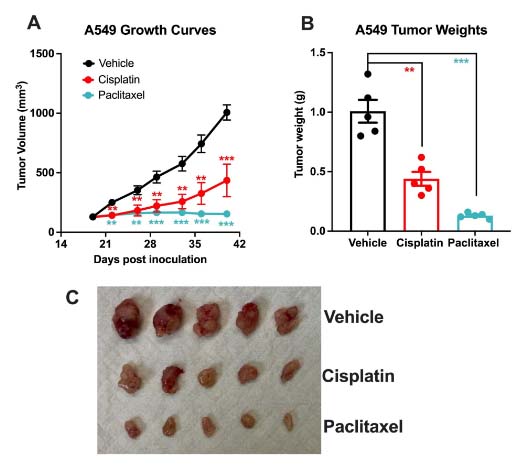The A549 Xenograft Model for Lung Cancer
A long history of reliability accessed in vivo
The A549 xenograft model utilizes a well-characterized cell line first cultured in 1972 from an explanted lung tumor of a 58-year-old caucasian male. A549 cells are one of the most popular cell lines used in the study of NSCLC for over 50 years, and implanting these established cells into mice offers a more realistic environment for testing novel lung cancer drugs in vivo. The A549 xenograft mouse model allows you to test your novel NSCLC drugs in a complex biological environment, helping you better understand your drug’s efficacy.
Accelerate your candidate’s journey to the clinic by easily monitoring its efficacy in a reliable in vivo model utilizing well-established A549 cells.
Advantages of the A549 Xenograft Model
- Mimic growth and invasive properties of NSCLC tumors accurately.
- Work with a familiar cell line in a novel 3D environment.
- Complete experiments faster with high-quality results.
- Reflect clinical treatment challenges with demonstrated chemotherapy resistance.
Customize your lung cancer research with our bespoke services
Our A549 xenograft model can be prepared in 2 to 3 weeks, with results available after 6 weeks of treatment.
Contact us for more information on our additional and individualized services, including IVIS imaging, PK studies, and metabolic analyses.
Chemotherapy validation in human lung cancer A549 xenograft model. 5 x106 A549 cells were subcutaneously injected into the rear flank of nude mice. Once the tumor size reached ~100mm3 (Day19), mice were randomized into either the vehicle control group (treated with normal saline), paclitaxel (20 mg/kg, IP twice/week), or cisplatin group (3 mg/kg, IP twice/week). Tumor volume was monitored twice per week using calipers (A). At the end of the study (Day 40), animals were sacrificed, tumors were excised and weighed (B, C). Data are mean ± SEM; n=5 /group; ** P<0.01, *** P<0.001 by Student’s t-test.
Did you know the A549 xenograft model is complementary to our syngeneic LLC model?
Melior makes syngeneic lung cancer models that use mouse rather than human lung cancer cell lines opening up the possibility of immune therapy testing. Our Lewis Lung Cancer (LLC) syngeneic model complements the human A549 xenograft model, and both are models of NSCLC.
Publications
Frequently Asked Questions
A549 are hypotriploid alveolar basal epithelial cells derived from an explanted lung tumor from a 58-year-old caucasian male. In our A549 xenograft model, these human cells are injected into the rear flank of a nude mouse to form a tumor reminiscent of a lung tumor growing in vivo.
This lung cancer model allows you to test drugs on a 3D human tumor in an in vivo environment.
The A549 xenograft model utilizes human lung tumor cells implanted inside mice, while the LLC syngenic model utilizes mouse cells implanted inside a mouse model.
This means that the A549 xenograft model is more predictive of how a human lung tumor would respond to treatment. Additionally, xenograft models use nude mice, which allows you to measure tumor response to treatment without immune interference.
In contrast, syngeneic models are immunocompetant and are therefore the ideal model for those seeking to test immune-modulating therapies.
A549 cells are injected subcutaneously into the rear flank of nude mice where they then grow to form a human lung tumor. This method allows researchers to study tumor growth, metastasis, and the efficacy of their therapeutic agents in a controlled and reproducible in vivo environment.
Citations
- The American Cancer Society. Key Statistics for Lung Cancer. Last revised Jan 29, 2024. Available at: https://www.cancer.org/cancer/types/lung-cancer/about/key-statistics.html






